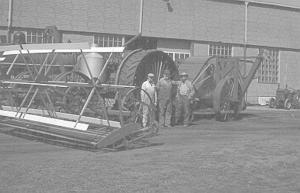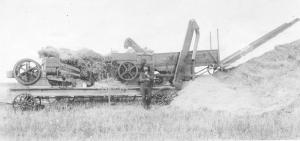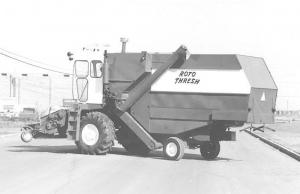2000 - Volume #24, Issue #3, Page #22
[ Sample Stories From This Issue | List of All Stories In This Issue | Print this story
| Read this issue]
Canadian Museum Features Old Threshing Equipment
 |
 |
 |
Today's descendant of the Hovland brothers' "central delivery reaper" is the swather. The Hovland's other creation, the "travelling thresher", contributed to the development of today's combine. That's according to the Western Development Museum in Saskatchewan, which has the original Hovland inventions in its collection.
Although August and Ole Hovland planted the seed for a technological revolution in agriculture, they never made a profit from their ideas.
"My father was an extremely gifted person, and extremely modest," says Warren Hovland, 80, Ole Hovland's only surviving son.
August and Ole Hovland took out homesteads near Ortley, South Dakota in the early 1900's. Money was scarce and so was farm labor, and the brothers searched for a more efficient way to harvest because traditional threshing crews relied on teams of horses and a gang of people to gather sheaves and pitch them into the threshing machine.
The Hovland brothers came up with a simple idea that ushered in modern farming. They noticed that cut grain seemed to dry better when lying loose rather than bundled into sheaves. On Feb. 25, 1907, August Hovland took out a patent for the "central delivery reaper" that would leave grain in long rows to dry. He also secured a patent for a "traveling thresher" that when pulled behind a tractor, would pick up the rows and thresh them on the spot.
But a farming practice that is taken for granted today was strongly resisted 90 years ago. The Hovland brothers started a company in 1909, but were unable to convince many other farmers about the merits of swath-threshing, as it was called.
The established farm equipment companies of the day ignored the Hovland brothers but paid close attention to the machines they created.
"The story came down that McCormick was resisting the idea, but when they saw the possibilities, they got patents that would prevent my father and brother from developing a commercial success," claims Warren Hovland, from his home in Oregon.
Hovland, a retired professor, says his father moved off the farm and spent most of his life as a telephone engineer in Chicago. Twenty years after helping develop the predecessors of the combine, he was able to see them become a reality on North American farms.
"I guess if my father had a better business sense about patents, maybe we'd be McCormicks instead of Hovlands," he jokes.
The Hovland brothers' machines sat deteriorating in a field in South Dakota until they were acquired by the Western Development Museum in 1963.
For more information about other artifacts in the Western Development Museum collection, please call the WDM Curatorial Centre at (306) 934-1400.
When Stanley-Jones threshing machines appeared in the early 1900's, some companies scoffed at what they called "little peppermills".
But it was a Saskatchewan entrepreneur named Arthur Stanley-Jones who had the last laugh. The innovative machines he helped build and sell enabled many farmers to thresh their own crops for the first time.
Stanley-Jones threshing machines were assembled until the early 1920s.
Today, Christopher Stanley-Jones says his grandfather saw the opportunity to build a machine that one person could operate.
"In those days there were threshing gangs touring the country," says Stanley-Jones from his farm in British Columbia.
"Without a one-man thresher, they were dependent on the larger gangs."
In the early 1900's, many people working homestead plots did not have enough money or labor to harvest their own crops. Every autumn, crews of young men crossed the plains, threshing from farm to farm. But the hectic schedule of the crews did not always suit the needs of farmers and as a result, some crops were harvested too early or too late. Farmers who weren't ready for threshing when the crews passed through could find themselves waiting until the following spring to take their crops off.
Arthur Stanley-Jones farmed only a few years befor

Click here to download page story appeared in.

Click here to read entire issue
To read the rest of this story, download this issue below or click here to register with your account number.




